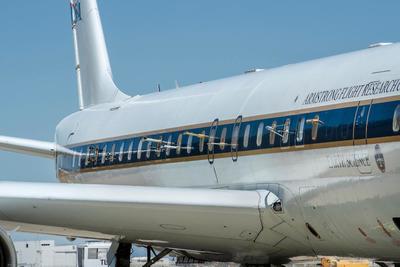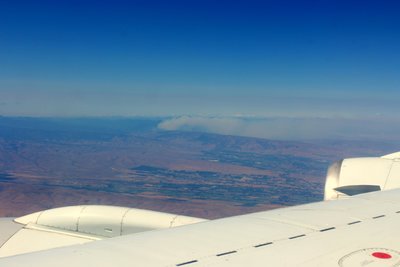Fire Influence on Regional to Global Environments and Air Quality (FIREX-AQ)
Description

The NASA DC-8 with instruments along the windows.
Photo by NASA Armstrong Flight Research Center / Ken Ulbrich.
Click for larger image, or view detail.
Approximately half of fire emissions in the US are from Northwestern wildfires and half are from prescribed fires that burn mostly in the Southeast US. Wildfires burn slightly more fuel and therefore have overall larger emissions, but prescribed fires dominate the area burned and the number of fires. FIREX-AQ will investigate both wild and prescribed fires. Wildfires generally result in exposures with larger pollution concentrations over larger areas, and cause both local and regional air quality impacts. Their emissions are often transported thousands of miles and can impact large regions of the US at a time. Prescribed fires are usually smaller and less intense than most wildfires but occur more frequently and throughout the whole year. They are usually ignited during periods that minimize population expose and air quality impacts, but can cause regional backgrounds to increase, are generally in closer proximity to populations, and are responsible for a large fraction of the US PM2.5 emissions.
The overarching objective of FIREX-AQ is to provide measurements of trace gas and aerosol emissions for wildfires and prescribed fires in great detail, relate them to fuel and fire conditions at the point of emission, characterize the conditions relating to plume rise, follow plumes downwind to understand chemical transformation and air quality impacts, and assess the efficacy of satellite detections for estimating the emissions from sampled fires.
Schedule for Summer 2019

Left Hand Fire in Washington State - July 30, 2019.
Photo by Rebecca Hornbrook. Click for larger image.
July 24 - August 18: Research flights from Boise, Idaho.
August 20 - September 15: Research flights from Salina, Kansas.
Forecasts of Chemical Weather
Links
- Principal Investigators NOAA and NASA.
- ACOM FIREX-AQ administrative page.
- ACOM Twitter account with frequent updates.
News
- Tracking Smoke From Fires to Improve Air Quality Forecasting (July 22, 2019).
- FIREX-AQ News at NOAA ESRL Chemical Sciences Division (Summer 2019).
- Just how bad are wildfires on our health? A high-tech lab will fly into smoke to find out (Idaho Statesman: August 2, 2019).
- Washington wildfire smoke triggered a thunderstorm – and NASA researchers flew through it (The Seattle Times: August 11, 2019).
- Sampling the Castle Fire (NASA Earth Observatory, August 13, 2019).
- Rare 'fire cloud' looks otherworldly in photo snapped from NASA's flying lab (NBC News: August 17, 2019).
- These Stunning Photos Reveal The Extremely Rare Phenomenon of a 'Fire Cloud' (Science Alert: August 20, 2019).
- What It’s Like to Work in a Flying Smoke Laboratory (Gizmodo: October 30, 2019).
Contact
Please direct questions/comments about this page to: